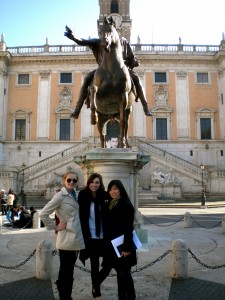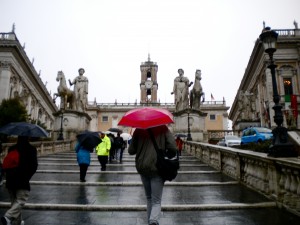Rome has so many sites of ancient importance, both famous and obscure, that it is difficult to pick out just one. But I can honestly say that my favorite location of the ancient city is located on the crest of the Capitoline Hill – the Campidoglio.
Beautiful in both rain and sun, this piazza was designed by Michelangelo but not finished in its entirety until under Benito Mussolini’s regime. After creating two complementary facades for the opposing palazzos that frame the square (they currently house the world-famous Capitoline Museums) Michelangelo also created a podium for the bronze statue of Marcus Aurelius, located in the central focal point of the Campodoglio as you ascend the steps to the Capitoline. The dizzying oval bands on the pavement form star-shaped intersections and were a part of the original design that was not implemented until the 1930s.
I love the Campidoglio because it is the setting of all of Rome’s greatest moments in history. It stands on the foundation of the giant Temple of Jupiter Optimus Maximus, where the empires’s most famous generals celebrated the triumphs of the Roman people. The tribute to Marcus Aurelius is a nod to the late empire, while the adjacent Church of Mary of the Heavenly Altar (Santa Maria in Aracoeli) is a reminder of the post-Roman world of the early Middle Ages. The Palazzos’ sprawling parlors and luxury that today hold some the the world’s great treasures reveal a taste of the unimaginable luxury of Renaissance Rome, while Mussolini’s final completion of the Campidoglio is a testament to the triumphs and failures of fascism.
Within its small boundaries, the Campidoglio holds all of Rome’s greatest moments.

